August 5, 2016
Air Date: August 5, 2016
FULL SHOW
SEGMENTS

Pre-Natal Exposure to DDT Boosts Breast Cancer Risk
View the page for this story
A study that used blood samples collected over 50 years ago finds that women who were exposed to DDT in the womb have a four-fold increase in breast cancer risk today. Study author Dr. Barbara Cohn of the Public Health Institute describes the finding to host Steve Curwood and suggests how we should think about DDT and chemical exposure in the larger context of reducing risk to public health. (07:15)
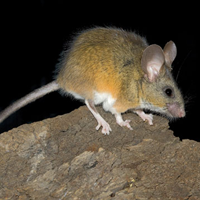
BPA Exposure Linked To Poor Parenting
View the page for this story
Humans today live in a sea of chemicals, and we are just beginning to understand how they affect our health. The endocrine-disrupting chemical Bisphenol-A has been linked to cancer, but new research from the University of Missouri found that the common substance seems to impair parenting behavior in mice. Scientist Cheryl Rosenfeld discusses the finding and its implications with host Steve Curwood. (07:50)
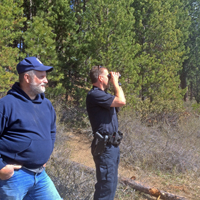
Poachers Slip through Underfunded Wildlife Enforcement
/ Tony SchickView the page for this story
Wildlife trafficking and crime is a global problem and the Pacific Northwest is not immune. While a small law enforcement and judicial team polices the large territory of Washington and Oregon states for wildlife infractions, limited resources, budget woes and loose laws allow poachers to evade penalties. And as EarthFix's Tony Schick reports, further underfunding and low prioritization of wildlife crime cases threaten to exacerbate the issue further. (04:25)
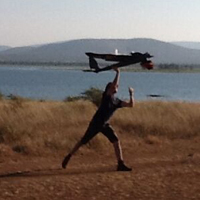
Wildlife Drones Stymie South African Poachers
View the page for this story
Poaching is a threat to the survival of rhinos worldwide, and anti-poaching efforts have always been one step behind. Now, park rangers in South Africa have a leg up. John Petersen from the Air Shepherd program tells host Steve Curwood how the power of predictive analytics combined with drone technology could help to rescue the rhinos. (05:55)
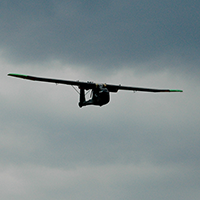
Drones are the Future of Agriculture
View the page for this story
About a third of crops are lost to diseases and pests, and while farmhands scout for problems in the field, assessing hundreds of acres is difficult. Now, a team of MIT engineers has equipped flying drones with cameras to better monitor farms. Host Steve Curwood talks with inventor Nikhil Vadhavkar about his project’s potential to increase crop yields and lessen the need for pesticides. (06:35)
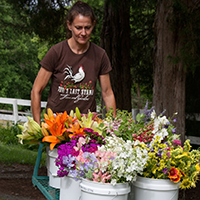
Planting the Seeds for Women Farmers
View the page for this story
Women farmers are increasingly challenging traditional, male-centric notions in the US about farming, as they innovate ways to best use their particular skills and abilities on the land. Farmer Audrey Levatino spoke with host Steve Curwood about what she’s learned from farming and the book she’s written to share that knowledge, Woman-Powered Farm. (16:00)
Show Credits and Funders
Show Transcript
HOST: Steve Curwood
GUESTS: Barbara Cohn, Cheryl Rosenfeld, John Petersen, Nikhil Vadhavkar, Audrey Levatino
REPORTERS: Tony Schick
[THEME]
CURWOOD: From PRI – it’s an encore edition of Living on Earth.
[THEME]
CURWOOD: I'm Steve Curwood. Early exposure to the banned pesticide DDT is linked to breast cancer decades later – and new research shows a four-fold increase for women exposed in the womb.
COHN: This is the very first study where we've actually been able to measure in utero exposure to an environmental chemical -- in this case, DDT -- and look forward 54 years at the risk of breast cancer for women who were exposed in utero.
CURWOOD: Also – MIT researchers dream up a new use for drones – to help farmers.
VADHAVKAR: So what a lot of people don’t realize is that a third of crops planted are lost to diseases, pests and insects, and to fight this in the US we apply about a billion pounds of pesticides, herbicides and fungicides every single year.
CURWOOD: Now drones help them accurately target pesticides to cut overall pollution. That and more this week, on Living on Earth – Stick Around!
[NEWSBREAK MUSIC: Boards Of Canada, “Zoetrope,” In A Beautiful Place Out In The Country, Warp Records 2000]
[THEME]
Pre-Natal Exposure to DDT Boosts Breast Cancer Risk
CHDS keeps the study’s blood samples, gathered from women and their descendants beginning in 1959, deep-frozen at negative 80 degrees Celsius. (Photo: Paige Cowett/WNYC with permission)
CURWOOD: From the Jennifer and Ted Stanley studios at the University of Massachusetts Boston and PRI, this is an encore edition of Living on Earth. I’m Steve Curwood. DDT was banned in the United States over forty years ago, a decade after Rachel Carson first raised the alarm about the pesticide in Silent Spring. And DDT has long been suspected in the human breast cancer epidemic, but research in the 1990’s could not demonstrate a credible link. In 2007 Dr. Barbara Cohn, of the Public Health Institute in Berkeley California talked to us about her study that linked pre-puberty exposure to DDT as a risk for breast cancer in adulthood, using indirect epidemiological evidence. Well, now Dr. Cohn joins us again, to explain how her team has taken this research a giant step further with evidence that matches DDT exposure in utero to elevated rates of breast cancer when women hit their fifties.
COHN: This is the very first study that I'm aware of where we have actually been able to measure in utero exposure to an environmental chemical — in this case DDT, which was a pesticide — and look forward 54 years at the risk of breast cancer for women who were exposed in utero. We found that women who had the highest levels of exposure, in the top 25% of exposure, had more than a 3.7 fold, almost a fourfold increase in risk of breast cancer by the age of 52.
CURWOOD: Why does the age of exposure matter with respect to breast cancer risk?
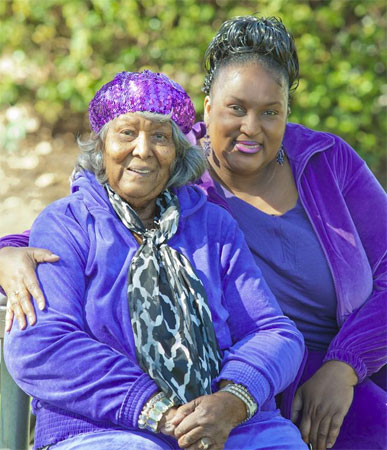
Willie Mae Washington, at left, became one of the first participants in the study more than fifty years ago. Her daughter Ida Washington, now 52, is in the second generation of the study. (Photo: Lindsey Konkel/Environmental Health News, CC)
COHN: Well, we know from animal studies, and we have other clues from humans as well, that there are particular periods in life when the breast is most vulnerable to something that might perturb its development and be related to breast cancer later on. One of those periods is in utero when the breast is forming. Another one of those periods is in puberty, or leading up to puberty, during the hormone storm of that time. Another period is pregnancy itself, when the breast is in a different state, preparing for lactation. Another period is likely when the breast is returning to its pre-lactation state, after pregnancy or after nursing has been completed. And then, finally, during the last hormone storm in the perimenopausal period, may be another period of risk. Different aspects are happening at each one of those points in time, and we expect that exposures during those times may have variable effects depending on when they happen.
CURWOOD: All these periods you've mentioned, as you say, are times of very intense levels of hormones. You call them “hormone storms.” Tell me a little bit more about that.
COHN: Well, we've long suspected that there are a number of environmental chemicals, and perhaps pharmaceuticals and other exposures, that can interfere with the signaling systems that hormones participate in. These chemicals that can interfere with these hormonal times are often called endocrine disrupters, and they may perturb the natural and normal signaling that is going on at these critical periods and alter the tissue, the cells, and even perhaps the instructions about how DNA and genes are turned on and off, so that, later in life — even much later — the tissue may have a higher risk to become cancerous.
CURWOOD: So what's next in this area of research?
COHN: Next, because there are not very many human studies with a 54 year follow-up like we have, will have to be done in the laboratory, where experimentalists can actually reproduce the timing of exposure and the doses that are analogous to what we found in our study, to first confirm whether they see changes in the breast or the mammary glands of animals that are similar to what we would expect based on our study; and, second, to see if they can understand mechanisms. Human studies never can prove causation. We don't do experiments on humans. And so it's always possible that there are some other chemicals or other exposures that underlie the DDT connection that we've seen. Animal studies are required to determine more carefully whether there's causation.
Dr. Cohn collaborates on her research with Dean Jones, professor of medicine and Director of the Clinical Biomarkers Laboratory at Emory University. Using a special high-resolution mass spectrometer, Jones and his colleagues are able to scan a drop of blood for tens of thousands of chemicals. (Photo: Paige Cowett/WNYC with permission)
CURWOOD: Now, DDT was banned more than, what, 40 years ago here in the United States. How concerned should Americans be about DDT today?
COHN: Our present is very much affected by our history, and what we're wondering is how far back we have to go for our history of exposure, to understand our present and our present risks. So here we have women who are very much alive, born in the 1960s, who are just beginning to face the risks of breast cancer that come with age. So that's the first answer to your question. The second answer is the World Health Organization has promoted the use of DDT for public health purposes in countries where malaria is still a very significant public health problem. And my research does not change the potential benefits for the use of DDT to control malaria, because malaria is a terrible public health concern, particularly for women and children. But it does change the assessment of potential risks for exposure to DDT. We have some more experience since the time the World Health Organization essentially re-authorized the use of DDT for malaria control, and the next step that people are talking about taking are ways to do a better job of protecting that vulnerable population, and still do what has to be done to control malaria.
CURWOOD: And for an individual listening to us who is saying, “Hey, how can I find out if I was exposed to DDT in utero,” what can or should she do?
COHN: A woman cannot go back and change the past, but she can change her future. And a recommendation is to look to the lifestyle guidelines that the American Cancer Society provides, work with her doctor to talk about what screening is appropriate for her, and also consider whether it might be right for her to try to avoid unnecessary exposures to chemicals that might be suspect, but that we don't really know about yet.
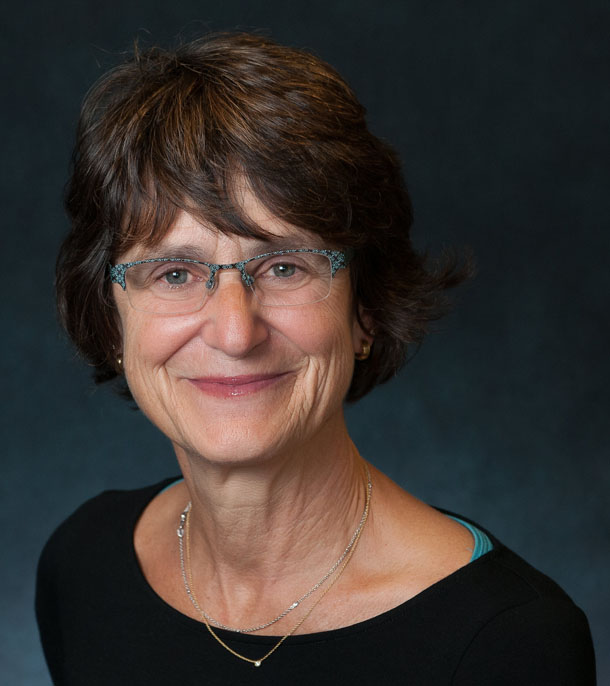
Dr. Barbara Cohn is the Director of the Child Health and Development Studies at the Public Health Institute in Berkeley, California. (Photo: courtesy of Dr. Barbara Cohn)
CURWOOD: Dr. Cohn, what do your findings tell us about what we need to be thinking about today, about the potential risks of the many chemicals we use?
COHN: Well, I believe this study is very much a proof-of-concept study. It's very unlikely that we'll be able to ever study the 80,000 chemicals that are out there, some of which may have the potential to increase risk for breast cancer and other health problems as well. Since we cannot do that, perhaps what the study is saying, that because there is this potential for these chemicals to do harm, we have to turn to the public policy arena to discuss what level of risk society is willing to take, and to examine carefully both the benefits and the risks of using certain classes of chemicals in our modern life.
CURWOOD: Dr. Barbara Cohn is an epidemiologist and Director of the Child Health and Development Studies at the nonprofit Public Health Institute in Berkeley, California. Dr. Cohn, thanks so much for taking the time today.
COHN: You’re welcome. Thank you for having me.
Related links:
- DDT study: “DDT Exposure in Utero and Breast Cancer”
- “Breast cancer and the environment: Studied for half a century, these women are ‘a national treasure’”
- Our story on DDT exposure during youth and breast cancer
- “What Causes Breast Cancer? These Mothers and Daughters May Hold a Clue”
- About Dr. Barbara Cohn
- “Pesticides: Toward DDT-Free Malaria Control”
- WHO statement: “The use of DDT in malaria vector control”
- Reducing the Risk of Breast Cancer
BPA Exposure Linked To Poor Parenting
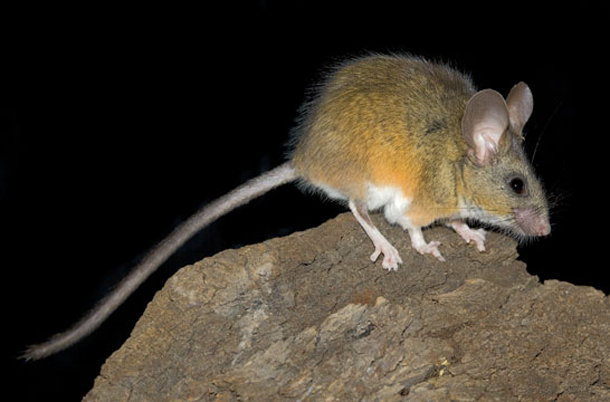
The California mouse was perfect animal model for this research because the species is monogamous and biparental. (Photo: Wikimedia, CC BY-SA 3.0)
CURWOOD: Well, though it’s banned in the US, DDT persists in the environment, and it’s a pesticide that, as well as being linked to cancer, disrupts hormones. Thousands of chemicals, including DDT, affect our bodies in ways we are only beginning to understand, including brain development and behavior. One chemical that’s gotten a lot of attention recently is Bisphenol-A or BPA, and a new animal study suggests that the chemical could have adverse impacts on parenting behavior. Joining us now to discuss the study is Cheryl Rosenfeld a Biomedical Sciences Professor at the College of Veterinary Medicine at the University of Missouri. Welcome to Living on Earth, Cheryl.
ROSENFELD: Thank you very much.
CURWOOD: So, first of all, remind us, what is BPA and where is it found?
ROSENFELD: Well, Bisphenol A is considered an endocrine disrupting chemical, and it's found essentially everywhere, because it’s in our everyday items. It's in our plastics, in our cardboards, it's even used in dental sealants. And the problem with Bisphenol A, it does not degrade in the environment, so it actually can bioaccumulate. They've done several studies looking at whether we can find it in the water and in terrestrial sources, and in almost all aquatic sources tested today there's been measurable amounts of Bisphenol A.

Concerns about BPA have prompted companies to take the chemical out of many common baby products. (Photo: Alicia Voorhies, Flickr CC BY-ND 2.0)
CURWOOD: And what are the health effects that have been demonstrated?
ROSENFELD: The health effects are many. These include cancers, reproductive deficiencies in males and females, neural behavior deficits, immunological problems, to list just but a few.
CURWOOD: So, as I understand it, you wanted to look at the impact of Bisphenol A, BPA, on parenting behaviors, and you did a study using mice. Why did you use the California mouse?
ROSENFELD: So we decided to use the California mice for these studies because unlike regular laboratory mice and rodents, they exhibit monogamy and they're biparental. And in the past studies they've only looked at maternal behaviors because they could not assess paternal effects, because in laboratory mice and rats, the dad does not play any parental investment.
CURWOOD: But in the California mouse, Dad cares.
ROSENFELD: That's correct. Dad does care, and he has to care very much because the survival of his offspring are dependent upon basically receiving parental care from both mom and dad.
CURWOOD: So, tell me about your study. What exactly did you do?
ROSENFELD: So what we did was, we developmentally exposed both males and females in utero and during the postnatal period to Bisphenol A in environmentally relevant concentrations. So we then took those F-1 offspring that were developmentally exposed to Bisphenol A and we did various combinations essentially where we would have, either they were both controls, or mom exposed to BPA, or dad was exposed to BPA or both.
CURWOOD: So what did you find? How did Bisphenol A affect the parenting behavior in these mice?
ROSENFELD: Well, similar to other studies with laboratory mice and rats, we found that developmental exposure to Bisphenol A reduced the maternal investments — time spent nursing, time spent in the nest, decreased if she was exposed to BPA. Likewise, and this is what is novel, we found that the dads who were also exposed to Bisphenol A spent less time in the nest with his pups. But what was really intriguing to us is if both parents were developmentally exposed to BPA, we had heightened effects. Essentially they both reduced their parental investment. We also found that control females who were paired with males who had been exposed to BPA reduced their parental investment, as assessed by time spent nursing and in the nest with the pups. And that was quite surprising to us, because she herself was a control, so she obviously could engage in normal parental behaviors, but it was almost as if she could sense the compromised state of her partner and she was going to reduce her parental investment in his offspring.
CURWOOD: So it's kind like in the human family, if dad is off drinking heavily and blowing all the money, mom says, “Well, not much I can do.”
ROSENFELD: That's kind of like a defeatist kind of attitude perhaps, but the thing too in rodents, you have to think about is they obviously want to save some of that energy back for the next litter. So she might say, “Well, look, he's not the best partner, and what if I can get a better partner? I want to invest in those offspring. So I'm going to save some of my energy resources for subsequent generations.”
CURWOOD: Well, wait, I thought they were monogamous?
ROSENFELD: They are, but if the partner dies in the wild, then they will pair up again with another male or female.
CURWOOD: So if they die or if they're a deadbeat apparently.
ROSENFELD: [LAUGHS] Maybe so. We haven't tested that hypothesis yet.
CURWOOD: So stepping back for a moment, Cheryl, what surprises you the most about your results?
ROSENFELD: Well, I think, essentially, the fact that paternal behaviors, just like maternal behaviors, are vulnerable to endocrine disrupting chemicals. This is what's unique because nobody has looked at how extrinsic factors like endocrine disruptors, paternal diet, stress, could affect his parental investment. And we need to start thinking about how those findings might relate to humans, because there's not been a single study to date that has looked at how Bisphenol A, or any EDC exposure, can affect parenting behavior in humans. And I think to me the long-standing consequences of having reduced parental care are incredibly important.
CURWOOD: Now, parenting behavior for humans seems like something that has to do a lot with culture and socioeconomics. How relevant do you think your findings are for humans?
ROSENFELD: So, you're correct, social, economic all play important roles in parenting, but if it comes down to it, it's actually guided a lot by what is called neuropeptide hormones in the brain. So let's say when the woman gives birth, she has a surge of what we call oxytocin. That lets the milk down in the breast and then the infant can feed. But it also, too, it really solidifies the maternal-infant bond. And it is now clear that even dads who just had their son or the daughter born, they also get a surge of oxytocin. And the same thing happens in our animal models. These parenting behaviors that we've been measuring are guided by hormones like oxytocin.
CURWOOD: So if that process is interfered with, then perhaps the bonding with the child is interfered with.
ROSENFELD: That's our hypothesis. That's what we’ve been looking into, in terms of how these chemicals can be affecting these hormones like oxytocin and related ones.
CURWOOD: BPA’s been removed from a number of products, but you note that it accumulates in the environment. So I'm wondering, to what extent do we continue to be exposed to BPA, even if we don't use BPA-containing products?
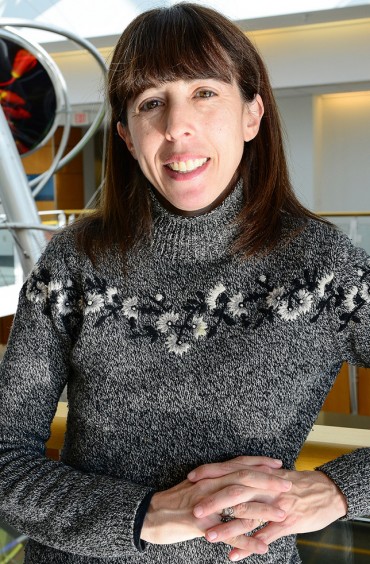
Cheryl Rosenfeld (Photo: University of Missouri)
ROSENFELD: Because it is in the environment, and it cannot degrade easily, our exposure is almost guaranteed. But that still does not mean that we should not reduce our exposure at this point. The FDA has banned it from the baby products. That's one possible mechanism by which many infants can be exposed to it; however, it still does not address the two primary routes of exposure, and that is the environment and the pregnant mother. So that pregnant mother is being exposed Bisphenol A while she's carrying her offspring, and that's probably the most critical period for a lot of the organ systems, including the brain.
CURWOOD: And Bisphenol A is just one out of many, many, many chemicals that have endocrine disrupting.
ROSENFELD: That's correct, and so I think we need to look at other ones, including heavy metals, air pollutants, nanoparticles — that's become very prevalent now in our environment as well — and decide if they affect maternal and paternal behaviors.
CURWOOD: Dr. Cheryl Rosenfeld teaches Biomedical Sciences at the College of Veterinary Medicine at the University of Missouri – and there’s more on both these studies at our website, LOE dot org.
Related links:
- Read the study in PLOS ONE
- About Cheryl Rosenfeld
[MUSIC: David Munnelly, “Ar Bhoitrin Na Smaointe,” By Heck, arr.D.Munnelly/R.Molloy, Mad River Records]
CURWOOD: Just ahead – A new use for drone technology -- to save endangered rhinos.
Stay tuned to Living on Earth.
ANNOUNCER: Support for Living on Earth comes from the Gordon and Betty Moore Foundation, and from a friend of Sailors for the Sea, working with boaters to restore ocean health.
[CUTAWAY MUSIC: Mike Marshall and Darol Anger, “Dolphins,” Chiaroscuro, Windham Hill Records]
Poachers Slip through Underfunded Wildlife Enforcement
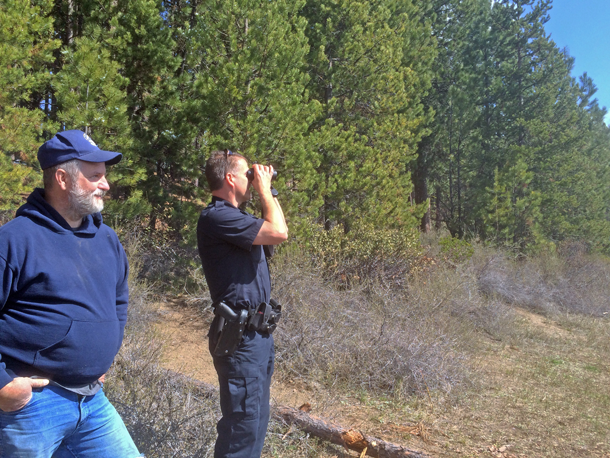
Darin Bean looks through binoculars at Twin Lakes while chatting with La Pine resident and fisherman Larry Archer. Bean cited Archer in the past for shooting a wildlife decoy. (Photo: Tony Schick, OPB/Earthfix)
CURWOOD: It’s Living on Earth, I’m Steve Curwood. Illegal Wildlife trafficking is a massive problem that’s bringing many species to the brink of extinction – rhinos, for example, or elephants, which are sought for their valuable horns and tusks. But it’s not just a problem in Africa and Asia – here in the US there are also species with horns that are ripe for lucrative poaching. For example, the trophy antlers of the Western mule deer can fetch a thousand dollars or more, and with strict limits on hunting, poachers are often meeting the demand. In Oregon there have been some recent arrests for mule deer poaching, but resources to catch poachers are spread very thin, and penalties aren’t high enough to be much of a deterrent. Still, Fish and Wildlife troopers are doing their best to protect dwindling numbers of mule deer. From Central Oregon Tony Schick from the public media collaborative EarthFix has the story.
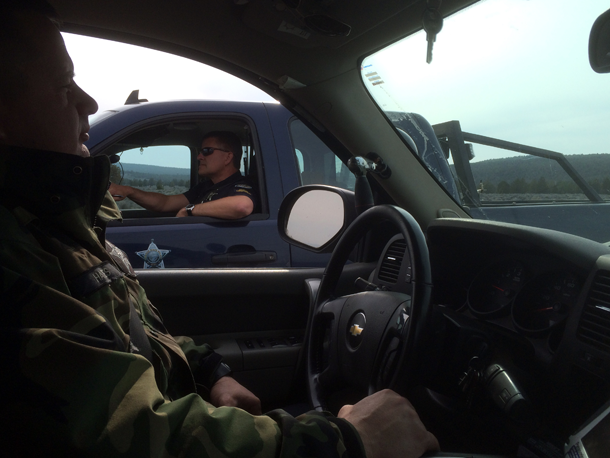
Oregon State Fish and Wildlife troopers James Hayes, left, and Darin Bean patrol several thousand square miles in central Oregon, where mule deer are in decline. (Photo: Tony Schick, OPB/EarthFix)
BEAN: “Hello .... State Police ...”
SCHICK: Oregon Fish and Wildlife Trooper Darin Bean is searching a home in the backwoods of La Pine, Oregon.
BEAN: “Boy, there’s a lot of little rooms in this place …”
SCHICK: A few months ago he caught a man here who illegally shot and stashed the carcass of a breeding female mule deer. He’s following up after a missed court date.
BEAN: “This is where they had the deer.”
SCHICK: He peeks around a dark doorway and shines his flashlight into a stained bathtub.
BEAN “You can see there’s still deer blood ... in the spare bathroom, ya know.”
SCHICK: Mule deer have been in sharp decline here, and poaching is one reason why.
It turns out at there are as many deer being killed illegally as there are by law-abiding hunters.
Declining budgets have left Oregon and Washington with fewer Fish and Wildlife troopers than they had in the 1980s. Both states are poised to lose more troopers this year.
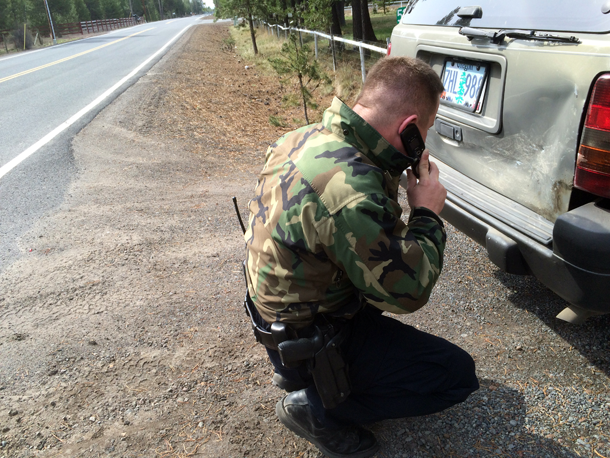
James Hayes examines the damage on a car he suspects was involved in a hit-and-run. Budget cuts in local law enforcement has led to some Fish and Wildlife troopers handling more general law enforcement. (Photo: Tony Schick, OPB/EarthFix)
Bean and his partner James Hayes are the only Fish and Wildlife officers patrolling more than five thousand square miles. And, they have less time to spend finding poachers as they used to. Their workload now includes more general law and time spent on safety checks for boats and ATVs.
BEAN: “Yeah, the days of just solo fish and wildlife are, you know … not anymore.”
SCHICK: On one shift alone, Bean and Hayes handled arsons, hit-and-runs and burglaries.
They still go hard after big poaching cases, and they think Gene Parsons is one of those.
BEAN: “Near as we can tell, that guy killed a tremendous amount of deer.”
SCHICK: They arrested Parsons in January and so far have charged him with 15 counts of violating Fish and Wildlife laws. Months later, he has been indicted but has not yet stood trial. He didn’t return phone calls.
BEAN: “He’d shoot 5-6 deer a night. And he’d cut the antlers off. With a chainsaw. And bring em home, and then a lot of times he would just, as near as we could tell, sell the antlers.”
SCHICK: Where poachers sell remains a mystery to them. But they recently received a tip about an antler dealer. He’s said to be in possession of several thousand dollars worth of stolen horns.
Hayes says if they can connect Parsons or other suspected poachers to this dealer, that could mean additional charges like racketeering. Penalties for poaching alone aren’t always a big deterrent.
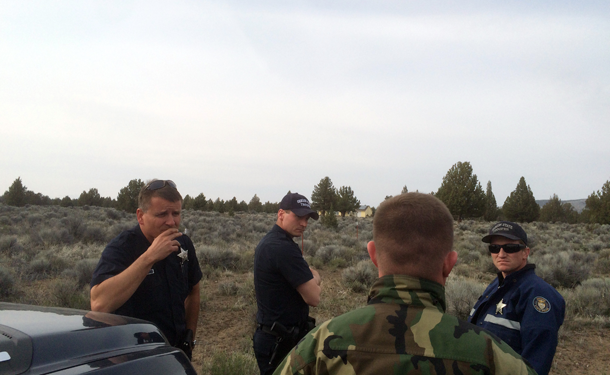
Fish and Wildlife troopers from Bend and La Pine wait outside the property of an antler dealer in Central Oregon. They need his help to track down some stolen antlers and connect suspected poachers to antler sales. (Photo: Tony Schick, OPB/EarthFix)
HAYES: “If there’s no jail time involved and it’s just monetary small fines, they’re not likely to quit … for your real criminals.”
SCHICK: Some Northwest counties prosecute Fish and Wildlife cases aggressively. Others dismiss a high number of cases or reduce them to small fines. Many lack the resources to go hard after poachers.
Just ask Ulys Stapleton, the lone Lake County prosecutor who handles a lot of cases from Bean and Hayes. His jail has 17 beds and he says most are claimed by people in drug-related crimes.
STAPLETON: “I understand why officers may be frustrated, but you don’t have the resources to throw everybody in jail. So what I try to do is I h’em up with a fine.”
SCHICK: The sun is setting on a windy day in Lake County by the time Hayes stops his truck at the antler dealer’s gate. Bean pulls up minutes later, along with troopers from Bend and John Day. They’re also tracking sales from poaching suspects.
HAYES: “Not home. (Second voice repeats, “Not home.”) Gate’s locked — padlocked. Looks like one set of tire tracks came out of there, maybe this morning.”
SCHICK: They meant to come earlier, but Bean was called to a burglar alarm.
They wait outside the property for a few tense minutes. Then the dealer returns a call to one of the Bend troopers.
BEAN: “Well, what’s the word?”
SCHICK: He’s gone for the evening. The antlers have moved on. His sale records aren’t at the house, either.
RING: “I said, I’m trying to run down some stolen horns, you know where they at? Who do you sell them to? He said ‘I’m running a business and I’m not in the business of telling you where I’m selling my stuff.’”
SCHICK: Out of options, they load up and they roll out. And the hunt goes. I’m Tony Schick in La Pine.
CURWOOD: Tony reports for the public media collaborative, EarthFix, and there are videos at our website, LOE.org.
Wildlife Drones Stymie South African Poachers
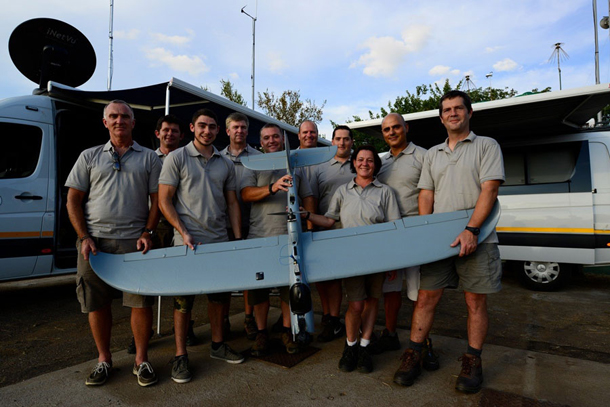
Staff members of South Africa-based UAV & Drone Solutions hold one of their drones. UAV supplies the drones and the ground crew for Air Shepherd. (Photo: Michael Romondo)
CURWOOD: Well, when it comes to poaching it’s not all bad news—in fact for some endangered rhinos there is an encouraging development to report. This good news comes in the wake of record number of rhinos slaughtered in 2014 by poachers in South Africa—an estimated 1200, with more taken elsewhere on the continent. Traditional Asian doctors believe that rhino horns have curative power, and market demand has driven some rhino species to the edge of extinction. But that demand is now running into a high tech enforcement system launched in South Africa to protect these large mammals. The Air Shepherd uses military-style computer analytics to identify poaching hot spots, and then sends silent drones equipped with night vision to track down poachers, who like to work after dark, when people can’t see them. John Petersen, Chairman of the Charles A. and Anne Morrow Lindbergh Foundation, that’s spearheading this effort, joins me now - Welcome to Living on Earth, John.
PETERSEN: Hi, Steve, nice be here.
CURWOOD: So you came up with the idea of using drones. How did you decide where to fly these drones?
PETERSEN: Well, that's the important kind of part of this, because some of these game parks are the size of Connecticut. That's where the experience of the University of Maryland comes into play, because they have developed a predictive analytic tool to tell us on a daily basis where the animals are likely to be and where the poachers are likely to be.
CURWOOD: Predictive analytics? How does that work?
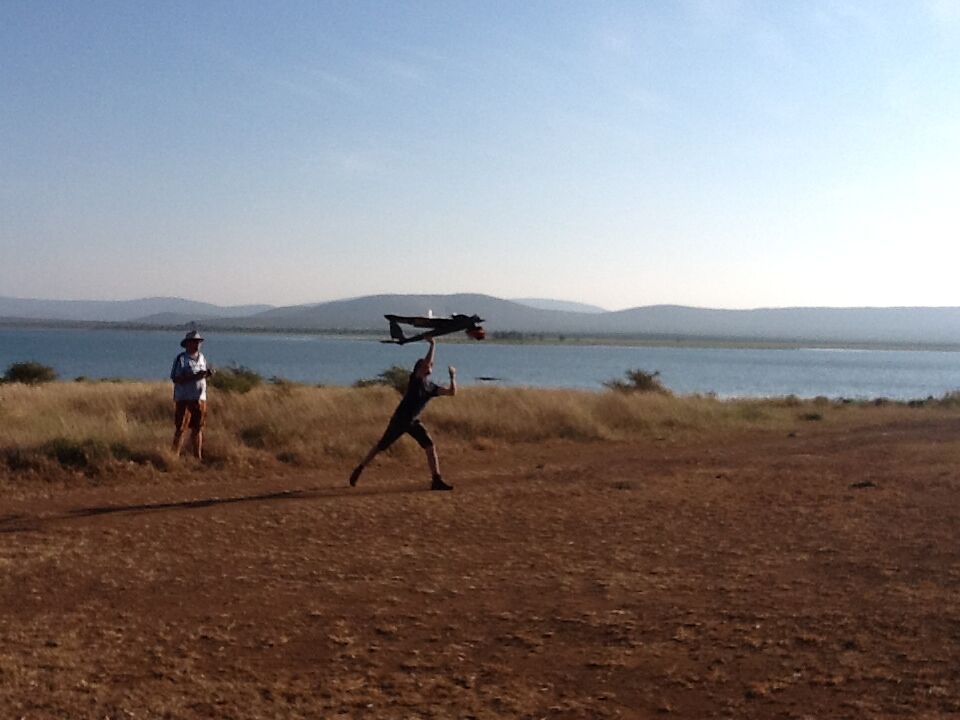
Launching an Air Shepherd drone. (Photo: UAV & Drone Solutions)
PETERSEN: Well, it's interesting because the University of Maryland got a contract a number of years ago with the Department of Defense to try to predict where roadside bombs were going to be in Afghanistan and Iraq. And by using historical information and topography and ingress routes and infrastructure and all those kinds of things, over time they got to become very highly accurate predicting where these bombs were going to be.
The head of that program, Dr. Tom Snitch, was very interested in the wildlife conservation area, and he figured out that you could take the same basic algorithms and repurpose them into the anti-poaching. And that's what we do, we've joined the most effective operational capability on the ground with this super computer-based predictive analytics, and where we've tested it, it stops poaching.
CURWOOD: How exactly would this work on a given day?
PETERSEN: The computers work all of the data and come up with a flight plan that says, tonight, here's where the problem is, and here's how you should fly your drone. And we download the flight plan, and you then pre-position the rangers in that area and you launch the drone, and it autonomously, automatically starts on this flight. And you monitor that information in the operations center, which is a mobile center that drives around out in the bush and launches and recovers the aircraft. And you see and look for both animals, and you look for the possibility of human beings. And, in most cases, they're in cars, and they drive down the road and they stop. Then you can alert the rangers, because they're positioned closely by, they can get there in a hurry, and they can capture the person and arrest them before they have a chance to kill the animal. And then you take all of the information of that day, all the environmental information, the information about the locations and so on, upload it to the computer as additional data, and it makes the database more robust.
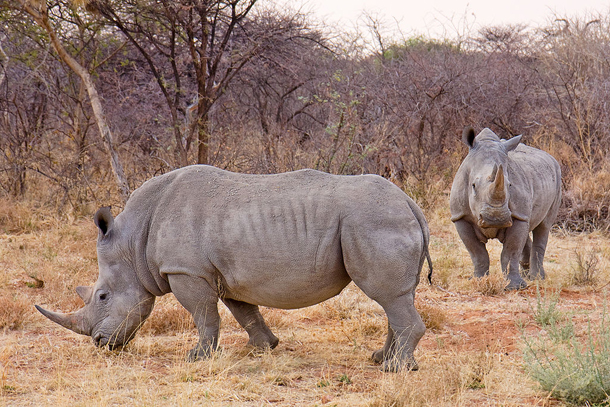
The white rhinoceros is actually grey; its northern subspecies is critically endangered. The southern subspecies is the most abundant rhino in the world, with over 20,000 individuals. South Africa is home to the largest population of rhinos in the world. (Photo: Ikiwaner, Wikipedia CC)
CURWOOD: So, this is a combination of folks on the ground, the drone being flown in real time, somebody looking at the data and giving a radio call to the authorities on the ground.
PETERSEN: That's it.
CURWOOD: How well does it work?
PETERSEN: In testing, and we’ve tested the drones by themselves — 1,000 hours, 650 missions flying in places where beforehand, for two years, they had lost 12 to 19 rhinos every month. For the six months that we flew in South Africa, there were no rhinos that were killed. And similarly and independently, we've tested the predictive analytics. In the two weeks that we tested that at a private game reserve, they captured 24 poachers, and, again, there were no animals killed. And so the combination of these two things are a capability that have extraordinary kind of potential, of really just shutting down the poaching where we are able to deploy them.
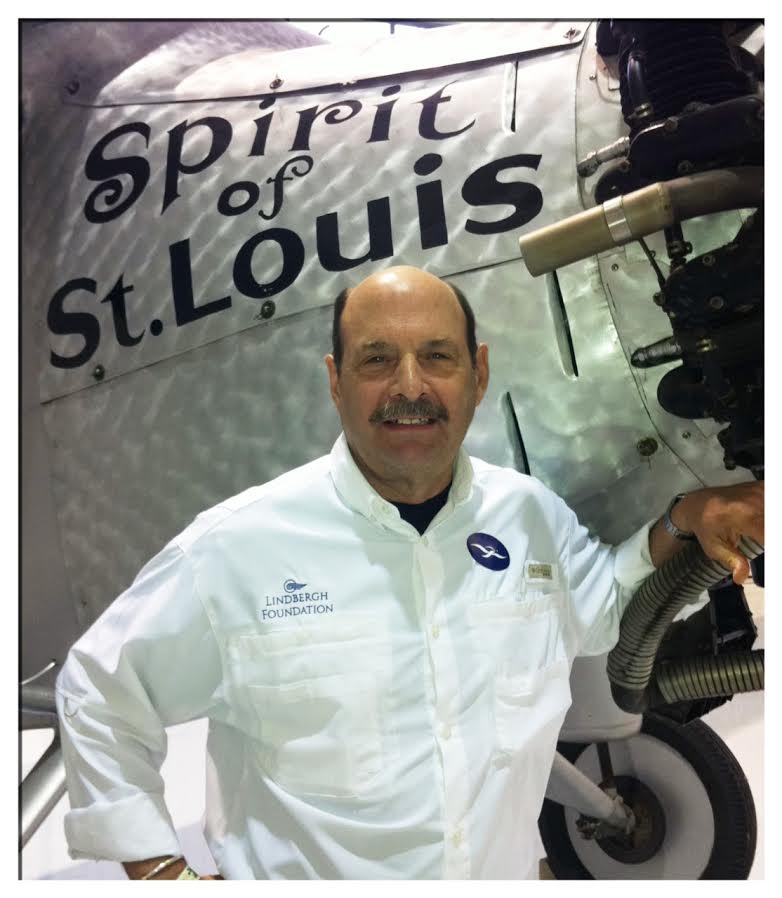
John Petersen is Chairman of the Charles A. and Anne Morrow Lindbergh Foundation, the organization behind the Air Shepherd program. Professionally, Peterson has been involved with initiatives that incorporate elements of technology, security, and anticipatory thinking and analysis. (Photo: courtesy of Diane Peterson)
CURWOOD: This must we very exciting.
PETERSEN: Well, it's extraordinary, because these animals that we've grown up with, these giant iconic animals, represent an essential aspect of who we are as human beings. And the thought that they would be extinct within eight or 10 years — which is what's going to happen at the present rate of killing if it continues — is just psychologically, fundamentally disconcerting. So it is exciting that we have a capability to be able to stop this poaching.
CURWOOD: John Petersen is chairman of the Lindbergh Foundation. His Air Shepard Program is successfully targeting rhino poachers in South Africa. Thanks so much for taking the time with us today.
PETERSEN: Great to be with you, Steve. Thanks so much.
Drones are the Future of Agriculture
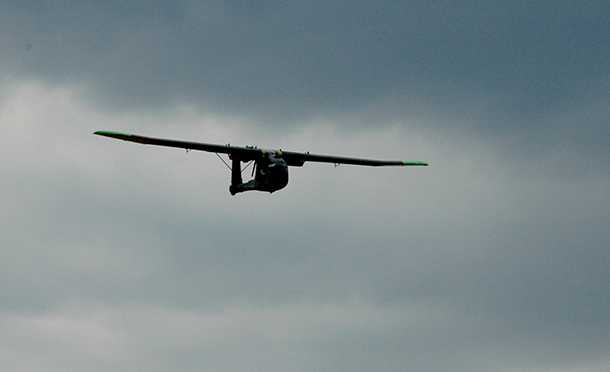
While they have received some pushback regarding privacy concerns, Nikhil says the agricultural community’s response to the company has been mostly positive. RaptorMaps plans to make its product available to farmers beginning next year. (Photo: courtesy of RaptorMaps)
CURWOOD: Another area where drones are already finding a place is on large farms. There they can help monitor the health of crops – without requiring hours of tramping in the fields. Drones can also be used to apply treatments – pesticides where there’s crop damage, or fertilizer where necessary. The idea of farm drones was dreamed up by Nikhil Vadhavkar, the CEO of the MIT startup RaptorMaps, and he explained how they work and how they could help fix a major problem.
VADHAVKAR: So what a lot of people don’t realize is that a third of crops planted are lost to diseases, pests and insects, and to fight this in the US we apply about a billion pounds of pesticides, herbicides and fungicides every single year. So at RaptorMaps we provide the service and analytical tools to enable farmers to accurately pinpoint where to apply these to reduce the total pesticide usage while simultaneously increasing crop yields. So we're enabling the entire system to be more efficient.
CURWOOD: So give me an example of how this might work.
VADHAVKAR: Sure. So right now let's say you're a crop scout for a farmer and your responsibility is to go out every single week and tell the farmer exactly what he or she needs to spray in order to protect the crops. You may only be able to cover a few hundred acres - so an acre is about the size of a football field - you may only be able to cover a few hundred in a day but you're making decisions about several thousand. So you can very easily miss something so we actually pre-scout the fields with our aircraft and enable 100 percent coverage and provide that information to the crop scouts so that they know exactly where the crops are stressed and where they need to apply their expertise when they actually go out to the field.
CURWOOD: So how can you tell if a crop is stressed by looking from a drone?
VADHAVKAR: So this technology was actually developed by NASA in the early days of Earth-observing satellites, so back in the 1970s. And what they noticed was if you look at vegetation in near infrared it actually will reflect quite a bit if the crop is healthy. So leaves have this layer called the mesophyll, and it’s very spongy, and that's what reflects. And when the crop is stressed that layer collapses and it can no longer reflect as much light. So what we do is we take that concept but we can apply it in a much, much higher resolution because we're much closer to the ground. We can fly underneath the cloud layer which actually prevents a lot of farmers from getting data for several weeks at a time and then most importantly we can provide repeat imagery week after week which enables us to monitor how fields are evolving.
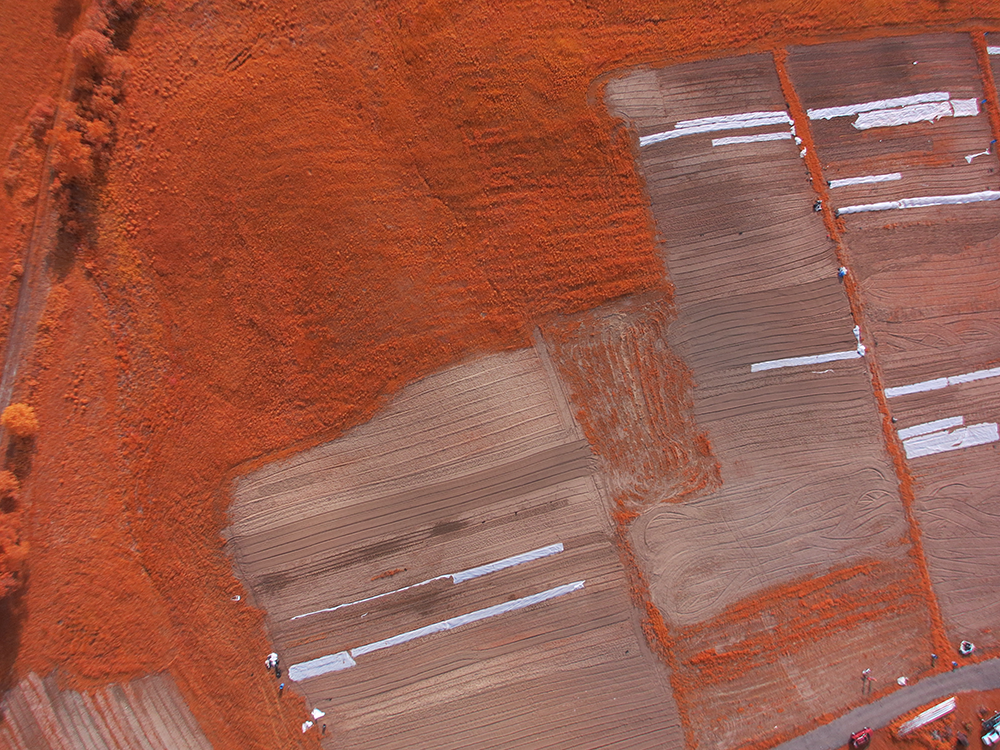
The drones take aerial infrared pictures of farmland. Healthy plants have a mesophyll layer that reflects lots of light, which can be seen from infrared images. Images with little reflected light indicate areas of poor crop health and inform farmers where to spot-treat with fertilizer or pesticide. This way fewer chemicals are used. (Photo: courtesy of RaptorMaps)
CURWOOD: How big are these things?
VADHAVKAR: So drones actually come in a variety of shapes and sizes. The ones we’re using are about seven feet in wingspan so they might actually seem—you know, I'm pretty tall and even if I stretch my arms out I can't quite hit the wing tips, but this is great because it allows us to put really nice imaging systems and allows these drones to stay up in the air for a long time.
CURWOOD: So they have batteries and lots of cameras and all that.
VADHAVKAR: The drones actually have multiple batteries and multiple imaging systems. Depending on the needs of a particular region, you can actually change the configuration, which is what we do.
CURWOOD: Now, how did you develop this crop mapping technology?
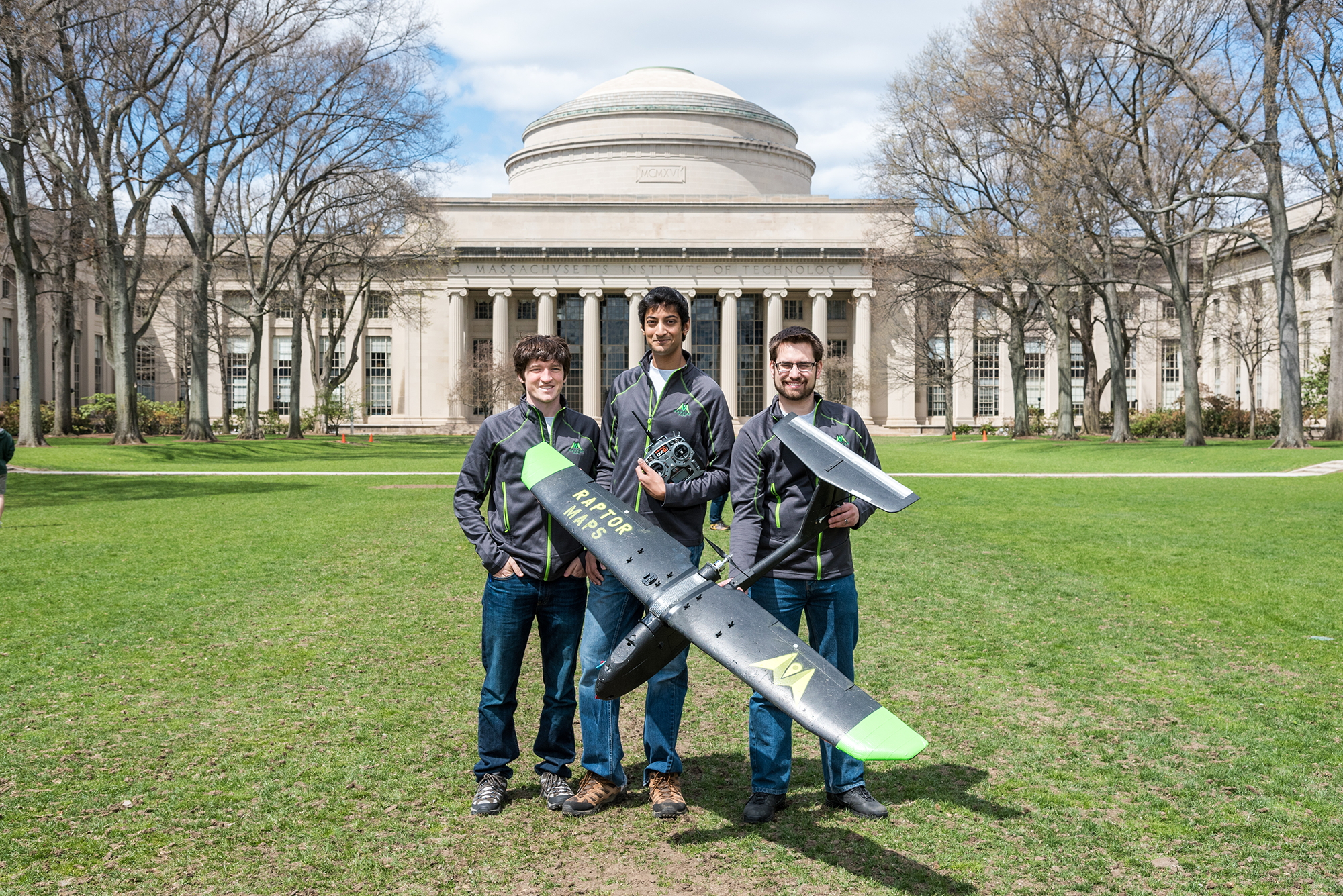
RaptorMaps was founded by three MIT engineers: Edward Obropta (left) is in charge of software, Forrest Meyen (right) manages operations, and Nikhil Vadhavkar (center) holds the new company’s executive position. RaptorMaps drones have a seven-foot wingspan and contain multiple batteries and imaging systems. (Photo: Adam Pan)
VADHAVKAR: So the idea kind of started when my friend Forrest and I, we actually both work in the Aero/Astro department at MIT and we were out on a NASA...what's called an analog mission. So we were in Idaho and we were simulating what it was like to be on Mars, and we noticed that the maps that we are able to get from satellite data were just not cutting it and so what the NASA folks did is they used drones to get real-time information that they needed to complete their mission, and so we kind of took that idea and ran with it and really saw that, hey, in agriculture this is exactly the application where you need that real-time data. And so, I have a background in drones, I actually led a grant from the Gates foundation to use drones to deliver emergency medical supplies, so we put our heads together and figured out that if we provide both the service and the analytical tools, then we can empower farmers to be much more efficient and preserve their crops.
CURWOOD: Nikhil, how ready do you think farmers are for this mapping technology?
VADHAVKAR: So I think farmers are extremely ready, and it just hasn't been presented in the right way. So what some companies are doing now is they're trying to sell aircraft directly to farmers, but really farmers want the information. So by providing the service and the analyzed data product, we're really de-risking it for them. We're saying, look you can get all the benefits of drone-derived technology which you can get in a way that you're very familiar with, and they've been very responsive to that approach.
CURWOOD: Now, of course, with the changing climate and the expected effects that include drought, flooding, higher temperatures and so forth, how important do you think drone technology is going to be in the future to help farmers feed a growing population?
VADHAVKAR: I think it's going to be extremely important. If you look at the population projections, unless we increase the efficiency of the farmland that we already have, it means we're going to have to create new farmland, and so when you do that you're taking way trees that right now really are helping to keep those carbon dioxide levels low.
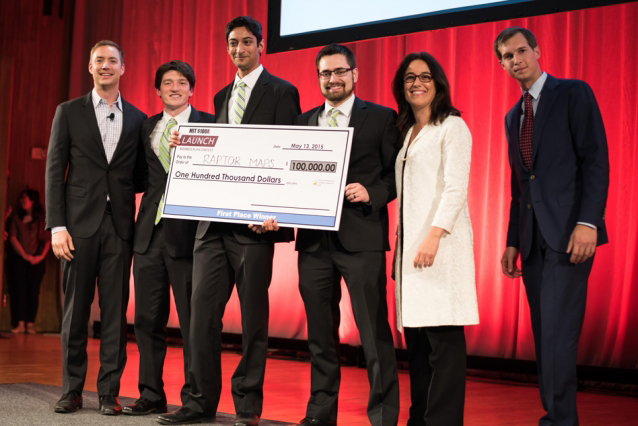
In May, RaptorMaps won MIT’s $100K Entrepreneurship Competition, which celebrated its 25th anniversary. The team plans to use the prize money to take their drone technology to the agricultural market. (Photo: MIT $100K)
CURWOOD: So what's the pushback that you're getting against this drone technology? There's not universal comfort with drones these days.
VADHAVKAR: Yeah, I think one of the biggest things is the privacy issue. People just want to know anytime you have some sort of aerial imaging system, people want to know that you can't spy on them or you're being very responsible with any data you collect, and so this really comes back to engagement of the customers and helping the farmers understand what we're doing. And so privacy is a big aspect and the other kind of push back is just regulatory but it's been great because in the past few months the FAA, they're using the Modernization Reform Act to approve exemptions and they've actually approved about 600 to date, so they really are starting to get on board with the drone technology and the climate is starting to thaw in the United States.
CURWOOD: Nikhil Vadhavkar is the CEO of RaptorMaps. That's an MIT-inspired start-up company based in Cambridge, Massachusetts. Nikhil, thanks for taking the time to talk with us today.
VADHAVKAR: Thank you. It was great to be here.
[MUSIC: Dr. Michael White, “Give It Up (Gypsy Second Line),” Dancing In the Sky, Basin Street Records (Reissued on New Orleans from Putumayo)]
CURWOOD: Coming up – A new book has practical advice for how to realize the dream of building a life on the farm – That’s just ahead on Living on Earth, stay tuned.
ANNOUNCER: Funding for Living on Earth comes from you, our listeners, and United Technologies - combining passion for science with engineering to create solutions designed for sustainability in the aerospace, food refrigeration and building industries. UTC companies such as Otis, Carrier, Pratt & Whitney and UTC Aerospace Systems are helping to move the world forward. This is PRI, Public Radio International.
[CUTAWAY MUSIC: Jake Shimabukuro et al, “Every Breath” Aloha To You, The Police, Sony and Hitchhike Records]
Planting the Seeds for Women Farmers
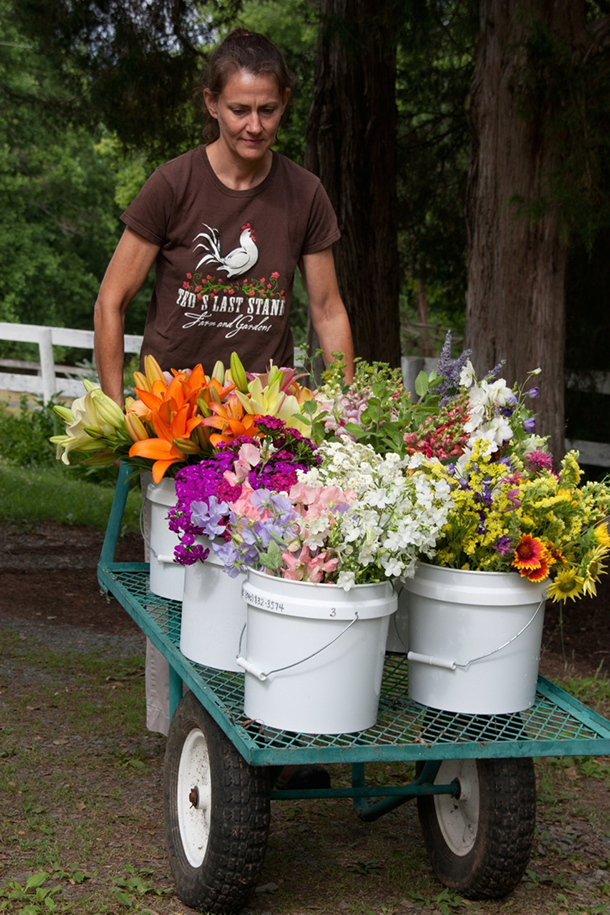
Audrey Levatino grows specialty cut flowers and sells them at local farmers’ markets to florists and restaurants, and for weddings. (Photo: Michael Levatino)
CURWOOD: It's Living on Earth, I'm Steve Curwood. It’s the busy season for small farmers all across America – when fresh produce at its peak must be harvested daily for the local farmer’s markets. And while women are usually the farmers in traditional societies, it’s a male dominated business in the US.
But women are coming on strong these days, especially raising and selling local home-grown vegetables and flowers and jellies and chutneys. One such farmer is Audrey Levatino, who has written a handbook for anyone seeking to grow local called “Woman-Powered Farm: Manual for a Self-Sufficient Lifestyle from Homestead to Field”. Well, we thought this might appeal to anyone who fancies a bit of manual labor – so we called her up. Audrey, welcome to Living on Earth!
LEVATINO: Well, thank you so much. It's great to be here.
CURWOOD: So, why did you decide to write a book about farming specifically for women?
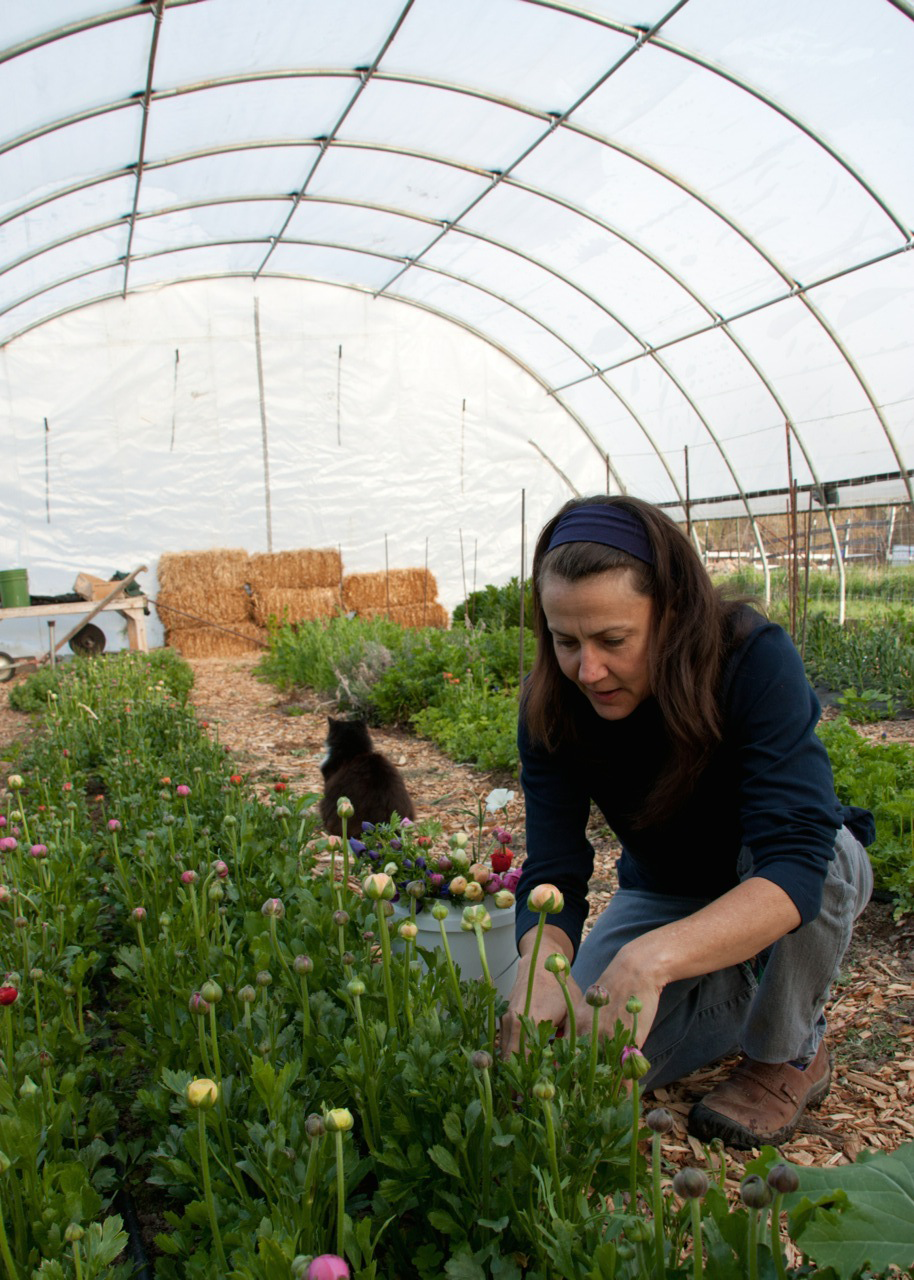
Audrey Levatino is the author of Woman-Powered Farm: Manual for a Self-Sufficient Lifestyle from Homestead to Field. With help from her husband Michael at the start, Audrey now grows numerous specialty cut flowers on their Virginia farm, Ted’s Last Stand. (Photo: Michael Levatino)
LEVATINO: Well, women were coming up to me at the farmers’ market and asking about what I did and were very interested. Many of them wanted to know how to get into farming and growing things themselves, and so they wanted advice and instructions on how to get started. Then I thought, most of these people are women around my age or younger, and when I first started out there wasn't just one book for a lot of the information that I wanted...I had piles and stacks of books. I started thinking about gathering all this information into one resource, a book just for women that addresses the concerns and interests that women farmers have.
CURWOOD: So what are the unique challenges that women farmers face as opposed to guys?
LEVATINO: Well, a lot of it is physical body strength. Men are built different than women so there's definitely going to be a bit of a different approach in terms of facing heavy-duty tasks. We really need to approach tasks with more creativity about how we can use our lower body strength and spare ourselves from injury, perhaps using wheels whenever we can instead of lifting up heavy buckets and carrying them, put them on a garden cart and wheel them over to where they need to be. There are many companies coming out with tools specifically designed for women to use. There's a shovel called HERShovel™ that has a wider foot base; you can get both your feet on there and really get some leverage and it has totally curved hook handle, so you can get both hands and grip. There's an easy start chainsaw that's a little bit lighter weight and it doesn't take that really strong pulling motion, easy hitch and unhitch implements for tractors because that's really the biggest deal with using a tractor is getting those implements attached to the tractor - that's where the strength comes in. Driving, anyone can drive something right? I hope. [LAUGHS]
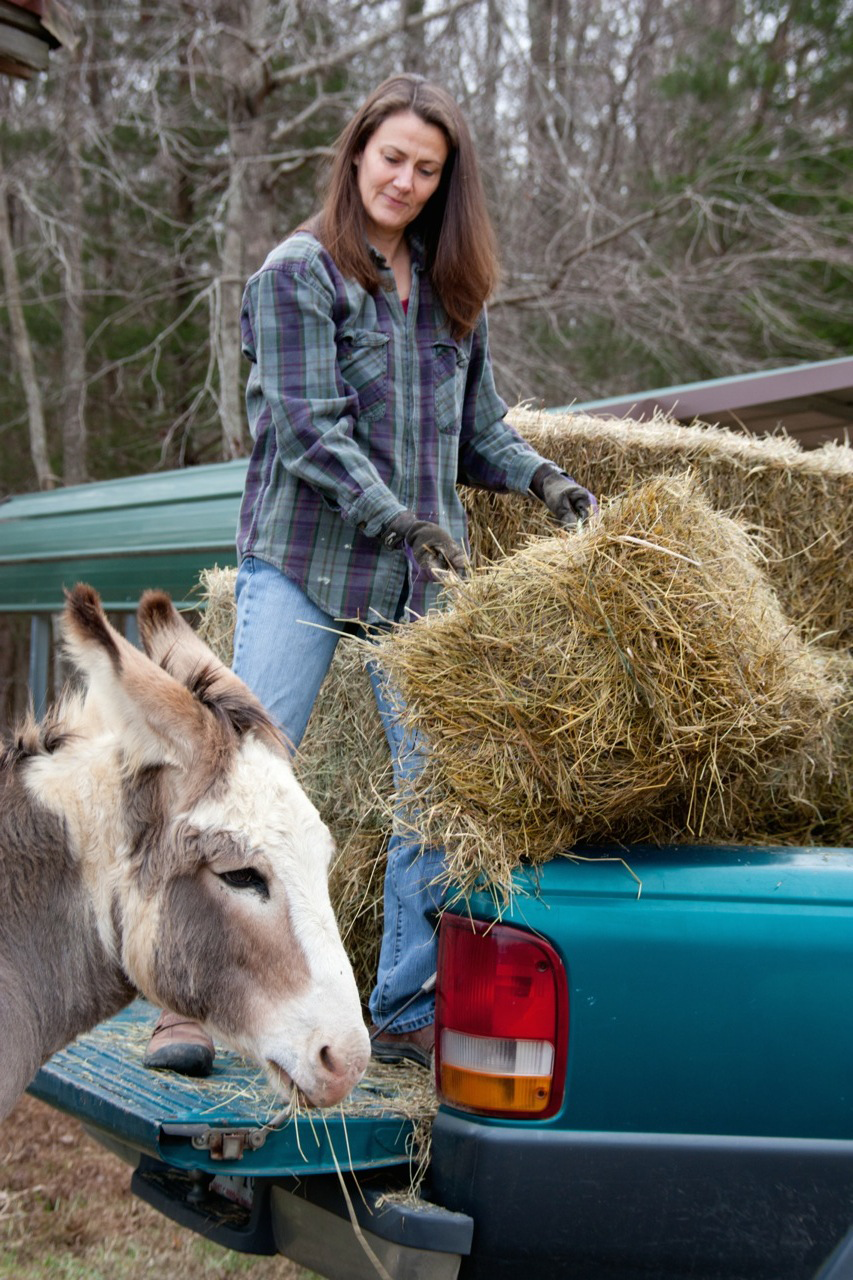
Whipper, one of two “gregarious” donkeys on Audrey’s farm, munches on some hay as Audrey unloads bales from the back of a truck. (Photo: Michael Levatino)
CURWOOD: Yes, but those attachments certainly can really weigh...in fact you have an interesting trick in your book, you say get a big iron crowbar to deal with attachments.
LEVATINO: Absolutely, I mean use that leverage! Again, I have another wonderful garden tool, the broad fork, and that's all about leverage. Use gravity whenever you can, make gravity work for you rather than against you.
CURWOOD: Audrey, what do women farm more typically as opposed to men?
LEVATINO: That's a great question, and that's another thing that I really investigated when I was writing the book and many women get into this farming business. It starts off as just wanting to provide the best, healthiest, most local food that they can for their families. So women are growing a lot of different things, but in many cases it is healthy, delicious, seasonal food. They know exactly where it came from, so that their children and their husbands and their neighbors can have the best food possible.
But the other thing that I discovered as I got further into my research and interviewed lots of women farmers in my area and around the country is women are just amazingly creative: they grow herbs and other medicinal plants to make teas, salves and tinctures. Women also tend to farm, when they do livestock, smaller animals. You know, things that are a little more manageable and sometimes it's for fiber - sheep and llamas and alpacas - other times it’s for milk such as using goats to make cheese. So it's not just one specific thing.
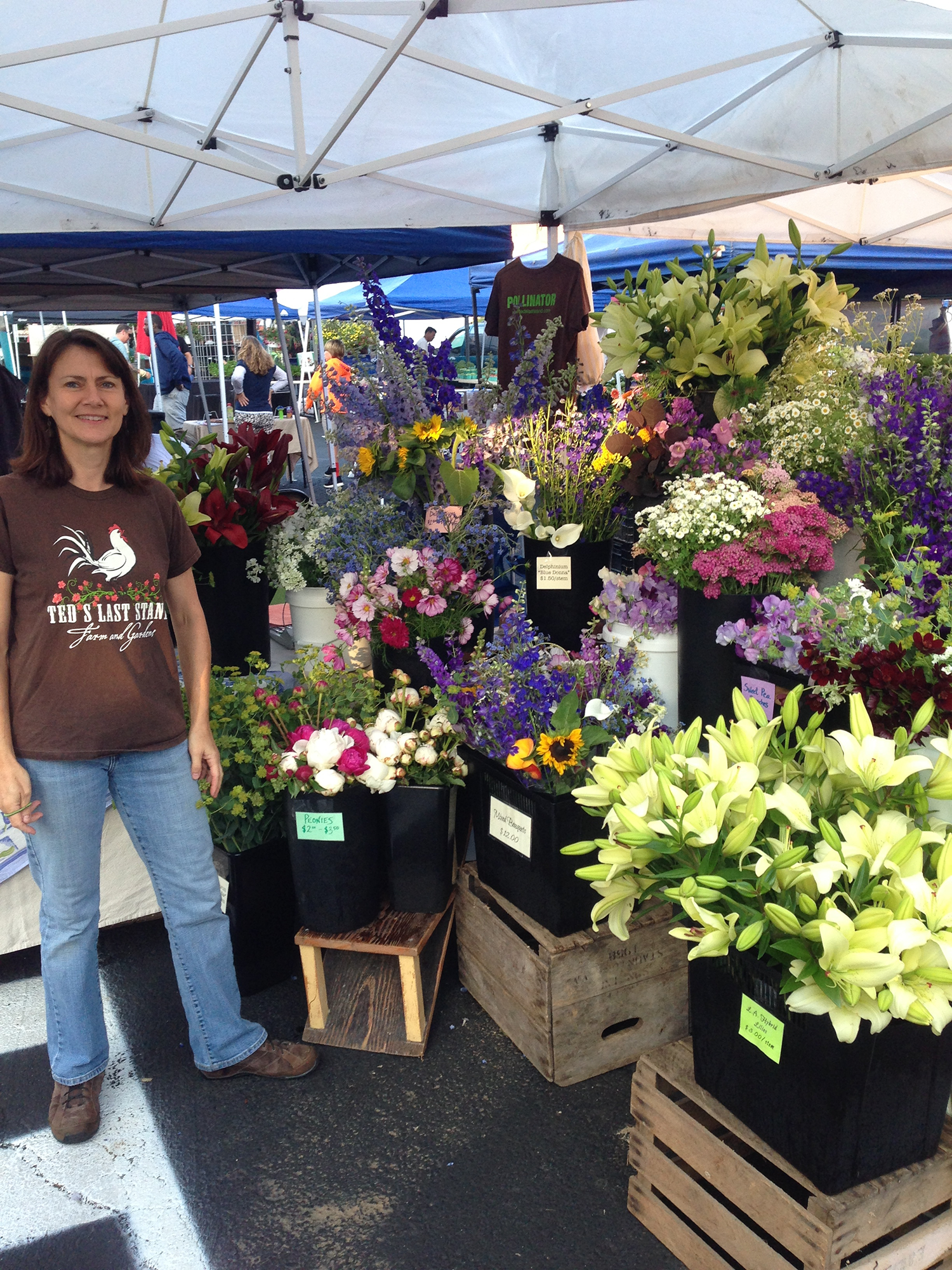
Farming, Audrey says, isn’t just about doing the physical labor of growing and harvesting a crop; it also involves understanding the local market for the product. (Photo: Michael Levatino)
CURWOOD: Now, you write that many women have particular qualities that lend themselves well for farming. What do you mean by that?
LEVATINO: I myself don't have children but I interviewed many women farmers who do have children, and a common analogy that would come up when they were talking about being a farmer and the work of farming was having children. One of the qualities that women have, most women, is being very nurturing, and that's a big part of farming, not just for livestock but also for your plants and vegetables and paying attention and noticing when something starts to go wrong. Women are very good at having that sixth sense of: “that's not quite right” and being able to catch diseases and bug infestations sooner rather than later, and I'm not saying that men aren't good at that but that's just something that I noticed in talking to women that came up quite a bit. They're also willing to keep trying, and I think again these are qualities that men have, but I think in women it really is a huge benefit in farming to just keep trying again. If something doesn't work you're going to try something else.
CURWOOD: Audrey, paint a picture for us. What's a typical day like on your farm?
LEVATINO: Well, most farmers - I think this is universal - get up very early. You've got to get things done first thing in the morning. You've got to get up and feed those animals, let them out into their pasture, water them - that's your first-order business - and if you're a plant farmer like myself - I grow mostly cut flowers - after I've fed my chickens, let them out of their coops, I go out and harvest. I spend my earliest coolest hours out in my flower fields harvesting flowers into buckets of water and I'll spend about two to three hours doing that in the morning and then I'll come in and take a break and eat some breakfast, check my e-mail, see if anybody has ordered more flowers, where do I need to go, what deliveries do I need to set up and then I go back out to the field.
The next order of business after harvesting is doing a thorough walk about—checking for bugs, eggs, on the leaves, aphids, any sort of disease that might be occurring in Virginia. We have a lot of humidity so rot can set in, and so I'm scooping bugs into water and feeding them to the chickens and then planting—getting in your next crop. If a crop needs to go in, then I need to prepare the row, put down landscape fabric if that's what needs to be done, get any crops planted for my next succession, and then weeding. That always falls to the bottom of the list and sometimes it doesn't get done, and sometimes if I have the time, social media, getting on and posting something on Facebook, or putting something new on the website. But that also tends to get pushed down the list quite a ways.
CURWOOD: Audrey, why do you cultivate mostly flowers?
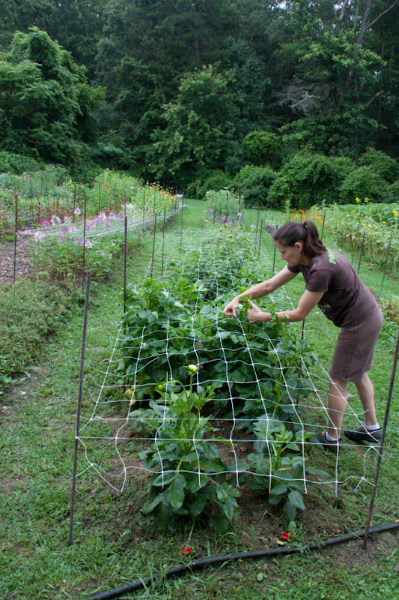
Audrey says she decided to cultivate flowers because she loves the bees they attract to her farm and the joy they bring to admiring customers at the farmers’ market. (Photo: Michael Levatino)
LEVATINO: I've always loved flowers and I got interested in it when I first started off with a vegetable garden. When I decided to make farming more of a full-time occupation, I looked around and was thinking about what might my market need. What would I enjoy doing? I love color and so I decided on flowers and just researched and started off small. Flowers, for one thing, they attract lots of pollinators, and I really love having the bees and all of the butterflies and the birds. When you have as many flowers as I do, that's just constant, and it's wonderful, and also flowers make people happy. I love to see the smiles on people's faces when they see the flowers and just the joy that flowers bring to people.
CURWOOD: So tell me about some of these flowers you grow. What different kinds?
LEVATINO: It's all seasonal. I grow most of the stuff myself, starting from seed, and I grow things like Ranunculus, Anemones, Delphinium, Chinese Forget-me-nots, Canterbury bells, Matthiola...all of those are really nice spring crops that like to get started in cool weather and once it gets hot - once it gets up to like 85 degrees - they're not very happy so they stop blooming. I have two unheated covered structures, which are called either high tunnels or hoop houses. They're just basically big metal hoops with greenhouse plastic over them that are all covered up in the winter and then you roll the sides up in the summer so that the air can get in and cool things off. And that allows me to start some really beautiful spring crops early, so that I can have some cool weather crops, and then I move on into the summery crops -- of course I have Zinnias and sunflowers and Gladiola, Queen Anne's lace, Rudbeckia, of course Larkspur. As summer goes on, the Dahlias start blooming, which are always very popular. I get Euphorbia Kilimanjaro, which is this green and white flower, which is lovely. So it's very seasonal but to try and keep enough variety in there, so that I can make bouquets and fill orders for weddings that require a little more diversity.
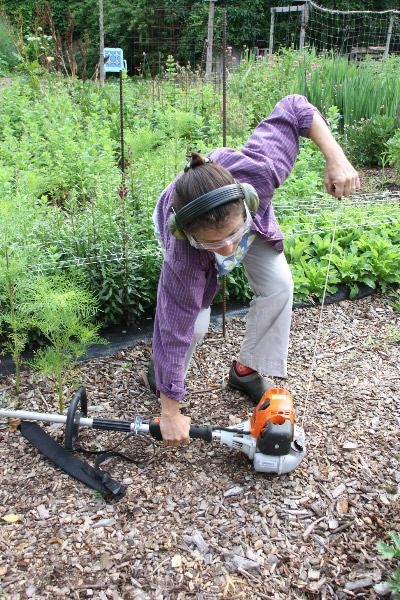
Audrey starts up a weedwhacker, determined to make a dent in the ever-encroaching weeds that threaten to crowd out her flowers. (Photo: Michael Levatino)
CURWOOD: Now, you didn't have much of a farming background when you started. How did you learn the skills that you need to run your farm?
LEVATINO: I'm very much trial and error and go out and figure it out yourself, which means that I made a lot of mistakes and that was another reason I wanted to write this book and share it with people. Also I learned a lot from books, workshops, the agricultural extension agencies in state through your universities have wonderful workshops and programs that can introduce you to things - that's how I learned about bees. I took a class through my agricultural extension agency and started beekeeping. Take advantage of the resources that are out there that are, for the most part, free or very inexpensive. And the main resource that I would say any farmer needs is other farmers. You've got to go out there and find the people in the community that are interested in what you're interested in that have been farming and that can be mentors because you're going to need help and that community of farmers is going to be a really strong support system for you.
CURWOOD: You write about one of your lessons in your book. You mostly do flowers but you also have donkeys and there is a story about the donkeys. Tell us the story.
LEVATINO: Well, first of all, we have about nine acres of pasture, and so when we first moved in, we felt like we really needed some grazing animals, the people who had owned the land before us had had horses. Horses are very high maintenance animals. Donkeys are about the lowest maintenance animal you can own, and they're also very cute and very gregarious. They are like having a couple of 350-pound unruly dogs. So we got the donkeys and just lovedthem. All of our pasture is surrounded by woods, and we get windstorms and lightning. And the trees get old, and limbs break off, so the fence needs to be under constant surveillance. You've got to do the walking the perimeter and I let that slip and one morning I realized...we have one donkey that's very vocal and he didn't make the noises he usually makes when a car starts up on our road and so when I went out to look for him, I found a breach in the fence and the story is about being unprepared for that circumstance and how I ended up dealing with it, and part of that was really relying on the community - neighbors and farmers and friends. But it was also a lesson in making sure that your fence is always in good repair.
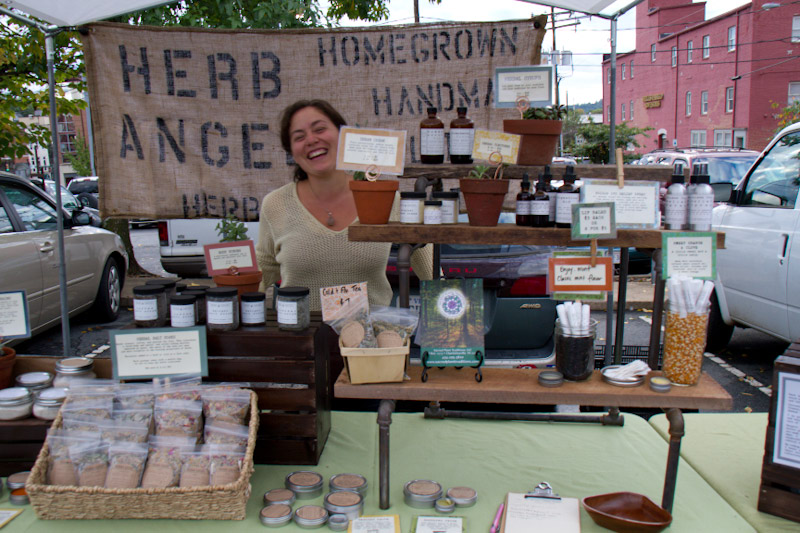
Angel Shockley, one of the women farmers Audrey profiles in her book, makes and sells herbs, teas, tinctures, and salves through her business, Herb Angel. (Photo: Michael Levatino)
CURWOOD: Indeed, mending fences is important, including with your neighbors. What did these donkeys do when they got out as far as your neighbors were concerned?
LEVATINO: [LAUGHS] Well, when I first reported it to animal control I said, I'm missing a couple of donkeys...they got out, and if anyone sees them can you let me know? About an hour later he called me back and apparently -- in quotations –“two white horses had been seen procreating in somebody else's yard”. And so that was the first sighting of the errant, wayward donkeys.
CURWOOD: [LAUGHS]
LEVATINO: And they're half-brothers and they just mess around like dogs, kind of mounting each other and wrestling, so this was quite embarrassing and also amusing really after-the-fact.
CURWOOD: So what was the biggest surprise that you encountered, as you went into farming and then went on to write this book to encourage more women to farm?
LEVATINO: When I first started out farming, my husband - he's had the same job but he wasn't quite as busy with that job - and so he was available to help me with a lot of things and that's how I learned how to do these chores, like using the chainsaw, and driving the tractor and cleaning the chimney. When he wasn't able to help me anymore I realized, wow, this is really, really hard work.
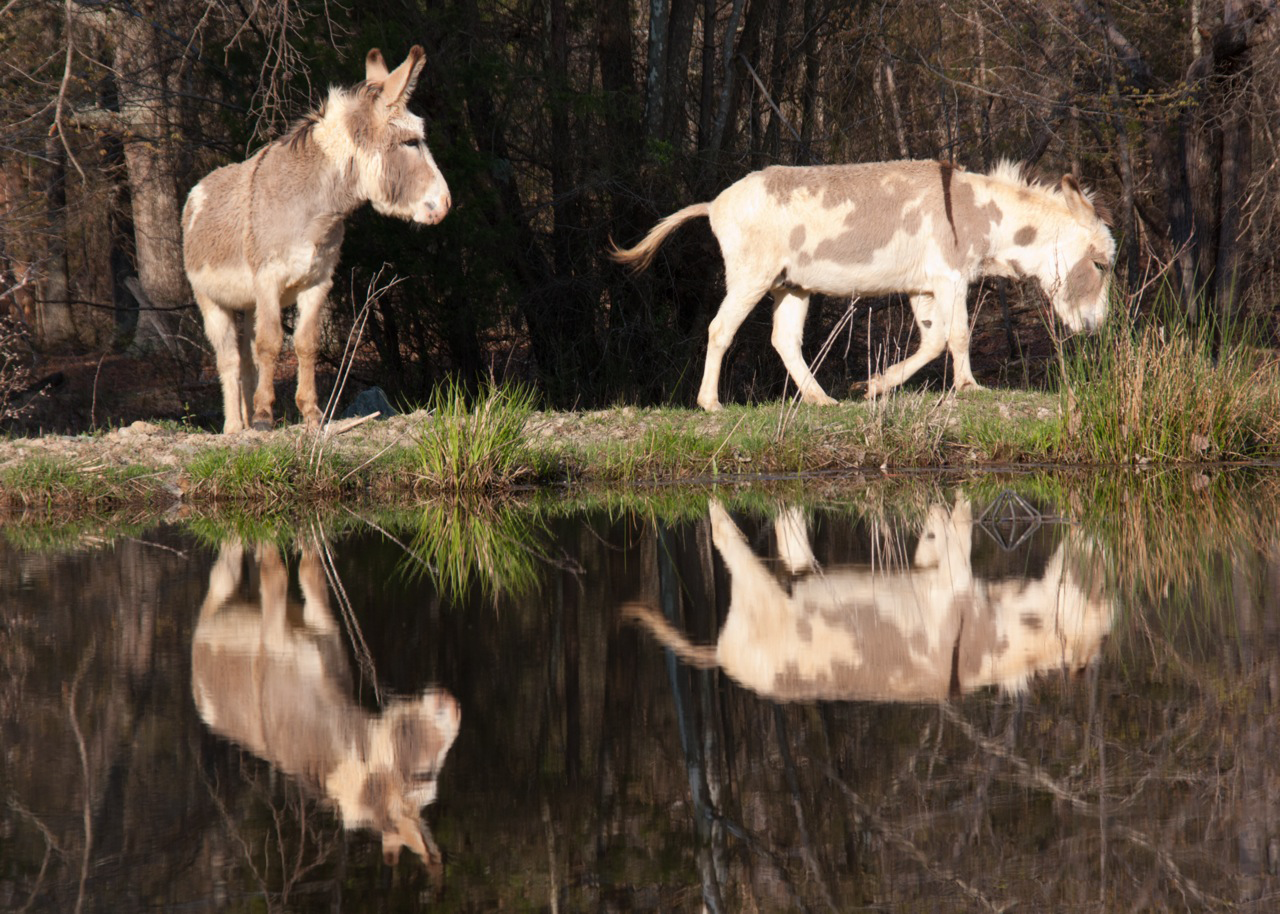
In a section of her book titled “The Great Donkey Escape,” Audrey details the story of how her donkeys, half-brothers Tyler and Whipper, escaped through the fence one day. Audrey found the donkeys later that day, but not before a neighbor noticed the brothers playing one of their favorite games—mounting each other. (Photo: Michael Levatino)
Being a farmer is really tough. You have to be self-motivating, have your own business plan, so it's not just doing the farm work, it's doing the accounting and planning out your succession plantings and your crops for the year and not just one year maybe two years and having an alternate plan because there's always going to be a weather incident or some sort of crop failure or a market's going to fall through and you have to know your market, you have to do the research, you have to stay innovative and on top of the game, so I think I underestimated how many hats I would have to wear to actually make this job and make my business a success. The other surprise was really just how much you end up loving it and being committed to it and having this fellowship and community feeling with other people that are in the same type of work and how that really builds a sense of belonging that I hadn't felt in this community before.
CURWOOD: Audrey, for whom did you write this book?
LEVATINO: Well, I wrote it to encourage and help inform women that are thinking about going into farming, but aren't quite sure or are hesitant about whether they think they're capable of doing it so it's really just a book that's for encouraging people to take that step. If you think you want to farm something, if you think you want to have a garden, if you think you want to start raising livestock, do it, take a chance. Of course, go out and explore and learn how to do it and then trust yourself.

Woman-Powered Farm includes how-to spreads on essential farming skills, such as chopping firewood, that take into account the particular abilities of women. (Photo: Michael Levatino)
CURWOOD: Well, for anyone who’s listening to us talk and is curious about farming, there's quite a bit of real practical information about what you need to do to get going on a small organic hand-raising scale. If you want to go into commodity soybeans probably this is not the book for you. So last question, why did you pick this approach? You know that the vast majority of agriculture in this country is done on the industrial scale.
LEVATINO: Right. Right. Well -- and again that is a trend that women are leading the change in that by having these smaller independent farms that raise specialty crops and niche crops and are getting away from that idea of Big Ag. I mean, Big Ag is certainly important, we've got a lot of people in this country and other countries to feed, but getting closer to the land and really raising food and taking care of the planet that that food comes from is part of that movement that I think women are in the forefront of.
So I wanted my farm to grow just as organically as everything else does. Basically I've created quite a little sustainable ecosystem: I have a pond, I have a mushroom grove, I've got the bees. So trying to create a balance in the nature on my property where everything works together and helps each other and is interdependent. I think and I hope that it's just again that nurturing attitude which is taking care of the Earth, as well as taking care of the people on the Earth.
CURWOOD: Audrey Levatino is author of "Woman-Powered Farm: A Manual for a Self-Sufficient Lifestyle from Homestead to Field”, and farmer of Ted's Last Stand Farm and Gardens. Audrey, thanks so much for taking the time with us today.
LEVATINO: Thank you.
[MUSIC: Billy Childs Ensemble, “Prelude in Bb Major,” Lyric, Lunacy Music]
CURWOOD: Living on Earth is holding a special symposium on our oceans and our future, and you are invited. Join me, Blue Planet champion Carl Safina, and UMass Boston ocean law and management expert John Duff, Friday afternoon on August 12th on Nantucket Island. Details are on our website at loe.org, or call 617-287-4122 for more information.
Living on Earth is produced by the World Media Foundation. Our crew includes Naomi Arenberg, Bobby Bascomb, Jenni Doering, Anica Green, Jay Feinstein, Emmett Fitzgerald, Jaime Kaiser, Don Lyman, Helen Palmer, Charlotte Rutty, Adelaide Chen, Jennifer Marquis and Jolanda Omari. Tom Tiger engineered our show, with help from Zack Ronald, Jake Rego and Noel Flatt. Alison Lirish Dean composed our themes. Find us anytime at L-O-E dot org - and like us, please, on Facebook - It’s PRI’s Living on Earth. And we tweet from @livingonearth. I'm Steve Curwood. Thanks for listening.
ANNOUNCER1: Funding for Living on Earth comes you, our listeners, and from the University of Massachusetts, Boston, in association with its School for the Environment, developing the next generation of environmental leaders. And from the Grantham Foundation for the protection of the environment, supporting strategic communications and collaboration in solving the world’s most pressing environmental problems. Support also comes from the Energy Foundation, serving the public interest by helping to build a strong, clean, energy economy, from Gilman Ordway, and from SolarCity, America’s solar power provider. SolarCity is dedicated to revolutionizing the way energy is delivered by giving customers a renewable alternative to fossil fuels. Information at 888-997-1703. That’s 888-997-1703.
ANNOUNCER2: PRI. Public Radio International.
Living on Earth wants to hear from you!
Living on Earth
62 Calef Highway, Suite 212
Lee, NH 03861
Telephone: 617-287-4121
E-mail: comments@loe.org
Newsletter [Click here]
Donate to Living on Earth!
Living on Earth is an independent media program and relies entirely on contributions from listeners and institutions supporting public service. Please donate now to preserve an independent environmental voice.
NewsletterLiving on Earth offers a weekly delivery of the show's rundown to your mailbox. Sign up for our newsletter today!
 Sailors For The Sea: Be the change you want to sea.
Sailors For The Sea: Be the change you want to sea.
 The Grantham Foundation for the Protection of the Environment: Committed to protecting and improving the health of the global environment.
The Grantham Foundation for the Protection of the Environment: Committed to protecting and improving the health of the global environment.
 Contribute to Living on Earth and receive, as our gift to you, an archival print of one of Mark Seth Lender's extraordinary wildlife photographs. Follow the link to see Mark's current collection of photographs.
Contribute to Living on Earth and receive, as our gift to you, an archival print of one of Mark Seth Lender's extraordinary wildlife photographs. Follow the link to see Mark's current collection of photographs.
 Buy a signed copy of Mark Seth Lender's book Smeagull the Seagull & support Living on Earth
Buy a signed copy of Mark Seth Lender's book Smeagull the Seagull & support Living on Earth

